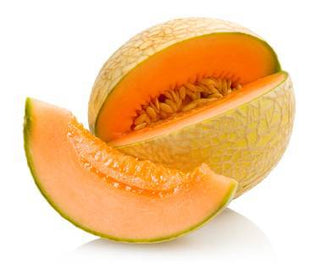(Cucumis melo)
Although it’s the most popular melon in the United States, cantaloupe as we know it is not really a cantaloupe at all it is a muskmelon.
True cantaloupes are primarily grown in France and are rarely found stateside. The variety most Americans enjoy is a hybrid between muskmelons and cantaloupes and exhibits qualities from both types of melon. These melons are closely related to cucumber, squash, pumpkin, and gourds and boast a rich flavor, musky aroma, and juicy texture. American cantaloupes are khaki green in color with netted skin and flesh ranging from light orange to nearly salmon.
The name cantaloupe is derived from the Italian papal village of Cantalup where the fruit was first cultivated in the 1700s. Cantaloupe were brought to America during colonial times but were not cultivated here until the late 19th century. Today, major growers include the United States, Turkey, Iran and many Central American countries.
Nutrition Facts
Juicy and delicious, a cup of cubed cantaloupe is 60 calories. While most of the calories are from sugars, a serving provides 2 grams of fiber and a gram of protein.
This succulent fruit is an excellent source of vitamins A and C and potassium. A cup of melon boasts 5,987 IUs of vitamin A, primarily in the form of beta-carotene. Cantaloupe provides the most beta-carotene in the entire melon family. A serving of this fruit provide 65 mg or 108% of the suggested daily intake. This fruits is also a good source of potassium, providing 473 mg or 14% of the suggested daily values.
Health Benefits
Cantaloupe is a concentrated source of beta-carotene that can be converted into vitamin A once inside the body. Both beta-carotene and vitamin A are important vision nutrients. Cantaloupe also contains carotenoids lutein and zeaxanthin. Studies have shown that a deficiency of these carotenoids may increase the risk developing Age Related Macular Degeneration (ARMD), the leading cause of blindness in the U.S.
Selection and Storage
Although cantaloupe can be found throughout the year, it is at its peak June through August.
Cantaloupe are often picked and shipped before they are ripe. When selecting, cantaloupe should be round and heavy for their size. Give the melon a tap with the palm of your hand; if it sounds hollow the fruit should be ready to eat. Look for a rind that is cream or khaki in color, free of any remnants of green. The stem end should be a bit indented and the opposite end should be slightly soft. Ripe cantaloupe has a sweet, fruity smell. Avoid melons with bruises or overly soft spots.
A melon can be kept on the counter for 2-4 days depending on the stage of ripeness. After this it can be stored in the refrigerator for up to 5 days. Sliced melons will keep for approximately three days in the refrigerator without any impact on the vitamins and nutrients. Remember to store cantaloupe in a tightly sealed container – the fruit is extremely fragrant and will penetrate other foods.
Before slicing your cantaloupe make sure to rinse the melon in warm soapy water. Although the rind is not eaten it often contains harmful bacteria (most notably Salmonella) that can be transferred to the flesh when the melon is sliced.
Recipes
Like nearly all fruit, cantaloupe is best enjoyed raw. This sweet, juicy fruit does not need anything extra to be a delicious treat. Provided the fruit is mature enough when picked, cantaloupes can be ripened in a bowl. For the best flavor, serve cantaloupe at room temperature and add some lemon.
Keep cool this summer by adding juiced and pureed cantaloupe to all of your chilled beverages. For a refreshing drink add some sparkling water to freshly squeezed cantaloupe juice. To liven up your summer cocktail, puree cantaloupe in a blender and then freeze in an ice cube tray. Add these sweet and pretty cubes to your lemonade or minty mojito.
Many of us are familiar with the classic antipasto of melon and prosciutto. For an interesting twist, try this version tossed with arugula, Prosciutto and Melon Salad with Cantaloupe Vinaigrette.
For an unusual and delicious take on a summer staple, the chicken salad sandwich, add cantaloupe!
Cantaloupe-Chicken Salad Sandwiches with Creamy Tarragon Dressing.
For a simple and fresh summer dessert as beautiful as it is delicious try Sliced Cantaloupe and Blueberries with Almond Cream.
Fun Facts
Cantaloupe is more closely related to cucumbers than to watermelons. A moldy cantaloupe in an Illinois market in 1941 was found to contain the highest quality penicillin after a worldwide search.

